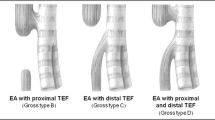Abstract
Purpose
To investigate the long-term morbidity of surgically treated esophageal atresia (EA) in adolescents and young adults and establish whether these long-term morbidities are affected by the type of EA.
Patients and methods
We reviewed the medical records, including backgrounds and associated conditions, of 69 long-term survivors of EA, aged >15 years. The long-term morbidities included neurodevelopmental abnormality, nutritional impairment (short height <−2SD, low BMI <18.5), subjective symptoms, and musculoskeletal deformities. Comparisons of the results were made between Gross A-type EA (n = 6) and Gross C-type EA (n = 63).
Results
All patients underwent esophageal anastomosis without esophageal replacement. Cardiac anomalies and long gap were present in 26 and 18%, respectively. Esophageal dilatation, fundoplication, and aortopexy were performed in 40, 34, and 18%, respectively. The incidence of long gap and esophageal stenosis was higher in Gross A-type EA than in Gross C-type EA. The long-term morbidities included neurodevelopmental abnormality (13%), nutritional impairment (62%: as short height in 34% and as low BMI in 46%), subjective symptoms (14%), and musculoskeletal deformities (59%). There were no differences in the long-term morbidities between Gross A and Gross C.
Conclusions
The incidence of the long-term morbidities is high in adolescents and young adults, regardless of the type of EA. Early detection of morbidity is important to improve the long-term outcomes of EA.


Similar content being viewed by others
References
Haight C, Towsley HA. Congenital atresia of esophagus with tracheoesophageal fistula. Extrapleural ligation and end-to-end anastomosis of esophageal segments. Surg Gynecol Obstet. 1943;76:672–88.
Okada A, Usui N, Inoue M, et al. Esophageal atresia in Osaka: a review of 39 years’ experience. J Pediatr Surg. 1997;32:1570–4.
Yagi M, Kohno M, Asagiri K, Ikeda T, Okada T, Kanada S, et al. Twenty-year trends in neonatal surgery based on a nationwide Japanese surveillance program. Pediatr Surg Int. 2015;31:955–62.
Sulkowski JP, Cooper JN, Lopez JJ, Jadcherla Y, Cuenot A, Mattei P, et al. Morbidity and mortality in patients with esophageal atresia. Surgery. 2014;156:483–91.
Pini Prato A, Carlucci M, Bagolan P, Gamba PG, Bernardi M, Leva E, et al. A cross-sectional nationwide survey on esophageal atresia and tracheoesophageal fistula. J Pediatr Surg. 2015;50:1441–56.
Taylor AC, Breen KJ, Audist A, Catto-Smith A, Clarnette T, Crameri J, et al. Gastroesophageal reflux and related pathology in adults who were born with esophageal atresia: a long term follow-up study. Clin Gastroenterol Hepatol. 2007;5:702–6.
Motrell AE, Azizkhan RG. Esophageal atresia repair with thoracotomy: the Cincinnati contemporary experience. Semin Pediatr Surg. 2009;18:12–9.
Sistonen SJ, Koivusalo A, Nieminen U, Lindahl H, Lohi J, Kero M, et al. Esophageal morbidity and function in adults with repaired esophageal atresia with tracheoesophageal fistula. A population-based long-term follow-up. Ann Surg. 2010;251:1167–73.
Cartabuke RH, Lopez R, Thota PN. Long-term esophageal and respiratory outcomes in children with esophageal atresia and tracheoesophageal fistula. Gastroenterol Rep. 2015 [Epub ahead of print].
Chetcuti P, Myers NA, Phelan PD, Beasley SW, Dickens DR. Chest wall deformity in patients with repaired esophageal atresia. J Pediatr Surg. 1989;24:244–7.
Jaureguizar E, Vazquez J, Murcia J, Diez Pardo JA. Morbid musculoskeletal sequelae of thoracotomy for tracheoesophageal atresia. J Pediatr Surg. 1985;20:511–4.
Gatzinsky V, Jönsson L, Ekerljung L, Friberg LG, Wennergren G. Long-term respiratory symptoms following oesophageal atresia. Acta Paediatr. 2011;100:1222–5.
Beucher J, Wagnon J, Daniel V, Habonimana E, Fremond B, Lapostolle C, et al. Long-term evaluation of respiratory status after esophageal atresia repair. Pediatr Pulmonol. 2013;48:188–94.
Spitz L. Esophageal atresia: past, present, and future. J Pediatr Surg. 1996;31:19–25.
Bouman NH, Koot HM, Hazebroek FW. Long-term physical, psychological, and social functioning of children with esophageal atresia. J Pediatr Surg. 1999;34:399–404.
Schier F, Korn S, Michel E. Experiences of a parent support group with the long-term consequences of esophageal atresia. J Pediatr Surg. 2001;36:605–10.
Zhang H, Du L, Du Z, Jiang H, Han D, Li Q. Association between childhood exposure to single general anesthesia and neurodevelopment: a systematic review and meta-analysis of cohort study. J Anesth. 2015;29:749–57.
Sanders RD, Hassell J, Davidson AJ, Robertson NJ, Ma D. Impact of anaesthetics and surgery on neurodevelopment: an update. Br J Anaesth. 2013;110(Suppl 1):i53–72.
Jsselstijn H, Gischler SJ, Toussaint L, Spoel M, Zijp MH, Tibboel D. Growth and development after oesophageal atresia surgery: Need for long-term multidisciplinary follow-up. Paediatr Respir Rev. 2016;19:34–8.
Ijsselstijn H, van Beelen NW, Wijnen RM. Esophageal atresia: long-term morbidities in adolescence and adulthood. Dis Esophagus. 2013;26:417–21.
Cartabuke RH, Lopez R, Thota PN. Long-term esophageal and respiratory outcomes in children with esophageal atresia and tracheoesophageal fistula. Gastroenterol Rep. 2015 [Epub ahead of print].
Connor MJ, Springford LR, Kapetanakis VV, Giuliani S. Esophageal atresia and transitional care-step 1: a systematic review and meta-analysis of the literature to define the prevalence of chronic long-term problems. Am J Surg. 2015;209:747–59.
Zani A, Cobellis G, Wolinska J, Chiu PP, Pierro A. Preservation of native esophagus in infants with pure esophageal atresia has good long-term outcomes despite significant postoperative morbidity. Pediatr Surg Int. 2016;32:113–7.
Sistonen SJ, Pakarinen MP, Rintala RJ. Long-term results of esophageal atresia: Helsinki experience and review of literature. Pediatr Surg Int. 2011;27:1141–9.
Author information
Authors and Affiliations
Corresponding author
Ethics declarations
Conflict of interest
We declare no conflicts of interest.
Rights and permissions
About this article
Cite this article
Okuyama, H., Tazuke, Y., Uenoa, T. et al. Long-term morbidity in adolescents and young adults with surgically treated esophageal atresia. Surg Today 47, 872–876 (2017). https://doi.org/10.1007/s00595-016-1462-x
Received:
Accepted:
Published:
Issue Date:
DOI: https://doi.org/10.1007/s00595-016-1462-x




